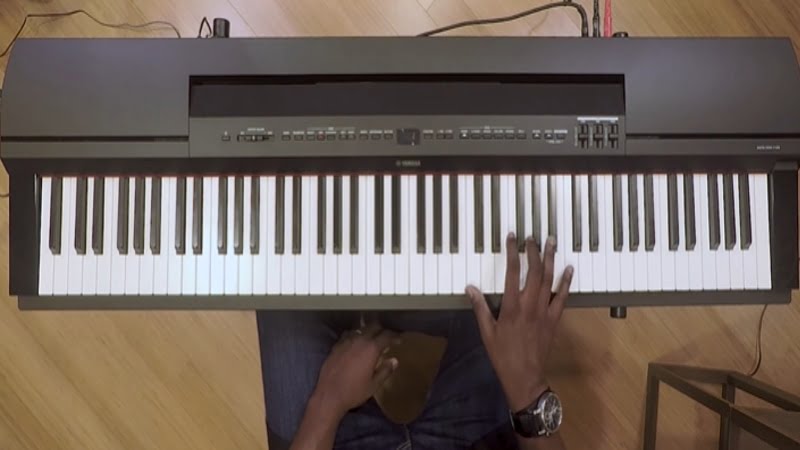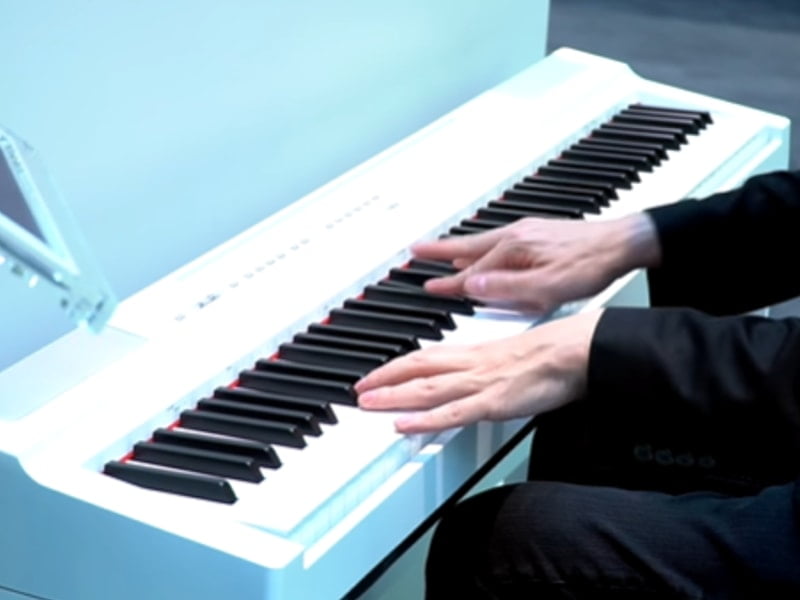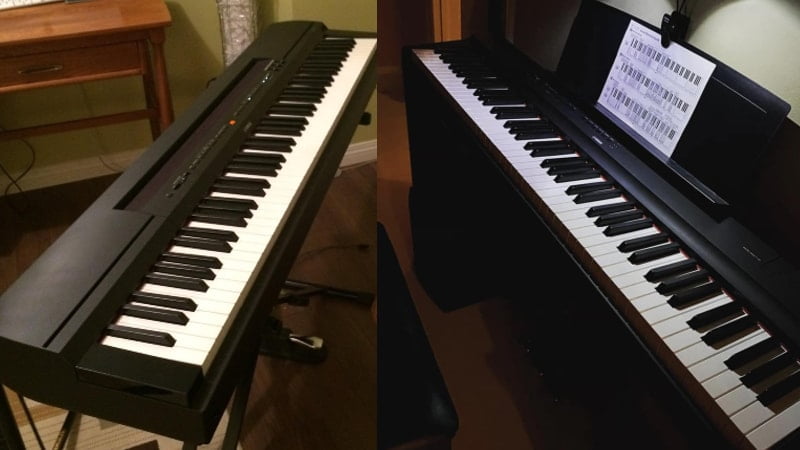Comparative reports on Yamaha P-255 vs P-125 are closely contested since both are favorably upgraded. But affordability gives the latter the upper hand for beginners.
Yamaha has one of the most enviable arsenals when it comes to digital pianos. Among these, the P-series (Portable) is considered by many as the best when it comes to functionality and, more importantly, competitive pricing.
The two models featured in this review, Yamaha P-255 vs Yamaha P-125, are huge favorites among beginners. Aside from the pretty impressive feel and sound of these digital pianos – great enough even for mid-level players – the two are lightweight, portable, and incredibly affordable.
After numerous revamps over the years (P-125 was P-115 and P255’s successor is the P515), the company is always trying to come up with new design ideas to be competitive with the time and other brands. And this is clearly obvious with their results
The question now is, which of these is the better choice – especially for those who are planning to get their own piece for home practice and even for gigs or performances in front of a crowd?
Yamaha P-255 vs P-125: Comparison Chart




Last update on 2025-07-11 / Affiliate links / Images from Amazon Product Advertising API
Yamaha P-255 vs P-125: Head-to-Head Comparison
Just by glancing at the table provided above, anyone can see that there are very few differences between the two Yamaha portable models – especially where it matters.
In terms of outward appearance, the P-255 is larger and heavier weighing over 38 pounds compared to P-125’s 26 pounds. The design features are pretty much the same too, with the control dashboard positioned above the keyboard. Perhaps the most obvious disparity is the number of speakers – both have upward-facing speakers directed at the player but the former has two additional amplifiers at the back.
But what’s inside matters more. And while there isn’t a lot of variance between the two, the actual disparities carry a lot of weight in determining which comes out on top.
After a very meticulous assessment of these digital pianos, I personally go for Yamaha’s P-125 over the presumed higher-model P-255 2:1;because of the lack of differences and, perhaps more importantly, because of the price tag.
But if you want to know more specifics, do read on.
Feel and Playability
The Winner: P-255
While the P-125 came a bit later than the P-255 as the successor to the P-115, Yamaha did not really make a whole lot of changes to it in this regard. While both are equipped with the same hammer action and touch sensitivity, the actual keys on the latter is of higher quality, furnishing it with the same feel as more expensive models.
+Hammer Action
The Graded Hammer System is Yamaha’s most basic hammer action, often used for their beginner-level digital pianos like the P-255 and the P-125. Aside from being sufficiently weighted, these are aptly weighted just like real acoustic uprights and grands with the bass keys on the left-most part of the keyboard having heavier pull than the trebles on the right-most side.

+Touch Sensitivity
This particular function refers to the volume and (more importantly) expression that is produced when the key is pressed – the sound is soft and lilting when softly touched and loud and resonant when pounded hard. All P-models, including the two reviewed here, have four settings available: Soft, Medium, Hard, and Fixed.
+Key Texture
This feature is where the P-255 becomes a better option than the P-125. The former’s keytops are made of synthetic ivory with moisture-absorbing capabilities that satisfactorily prevents the fingers from accidentally slipping. The latter’s plastic keytops may be laden with a matte material which also increases friction, but nothing beats the feel of ivory under one’s fingertips – even faux ones.
Tone
The Winner: Tie
Priced at almost two thousand bucks, I was really hoping for a better sound engine and a wider sound library on the P-255. Unfortunately, it has essentially the same specs as the P-125 in this regard.
The two P-models are tied in this section only because they have the exact same features; but the P-125 is my personal choice if its price tag of less than $1000 were to be included in the mix.
+Tone Generator
While most models from the P-series make use of the basic AWM sampling, these two are outfitted with the Pure CF Sound, generated from the world-class Yamaha CF grand pianos.
However, there are three functions added to the P-255 which makes it slightly better than the P-125: Key-off sampling, sustain sampling, and string resonance. Without going much into detail, these three help create piano sounds almost similar to real acoustic ones.
+Sound Library
With a whopping 24 voices, both the P-255 and the P-125 do not disappoint. The list includes a grand piano section, electric pianos, organs, vibraphones, strings, and bass.
Because the two are outfitted with the Pure CF tone generator, the grand piano instruments on both are no less than stunning. I do have to say that I was a bit more awed by the strings on the P-255, with the individual notes blending incredibly well. Its bass section is also wonderfully made.
Piano Functions and Features
The Winner: P-255
The P-255 does have an edge over the P-125 in this category, thanks to its higher polyphony count and more powerful speaker system. Usually, that’s enough to make me gush over a digital piano. However, that’s a very tiny edge here, in my opinion. Aside from the sheer similarities in other features and functions, it’s really hard to ignore the disparity in price.
+Polyphony
This feature is defined as the number of notes which can be played at once. The digital pianos in question are outstanding in this regard, with the P-125 having 192 and the P-255 having a massive count of 256. In fact, anything over 100 is already a great piece, especially for beginners. But the P-255’s count is the same as a Clavinova already – and that’s a huge treat even for expert musicians.
+Playing Modes
Both the P-255 and the P-125 share the often-required playing modes: Lesson, Layering, and Split. The first one is a must-have for beginners since this allows them to practice with their tutors.The last two are great for intermediate-level players who like to experiment with music, especially when mixing two or more instruments together for a composition.

+Effects
The two share the same basic effects including four types of Reverb, Sound Boost, and Damper Resonance, just to name a few. Aside from the additional functions that enhance the P-255’s sound engine, Yamaha sprinkled a few more to it like the Rotary Speaker, Phaser, and Tremolo or Auto Pan.
+Recording Capability
Apart from the numerous preset songs on these digital pianos, it is possible to record additional tracks – an awesome function especially for those who want to listen to their practice sessions or new compositions.
Both the P-255 and the P-125 can record two tracks as a standard MIDI file. However, only the former can save files on an external drive.
+Speaker System
The P-255 is ahead of the whole P-series pack in this aspect, having four separate speakers (two facing up and two facing the back/audience), making it a great stage digital piano. On top of that, there is no sound distortion heard at full volume – a real feat for Yamaha to effectively execute.
+Accessories
The two usually come with a music rest and a foot pedal in the set.
Yamaha P-255 vs P-125: The Similarities
As I have voiced several times, the two are matched in almost every single feature – from the very important hammer action and tone generation to the less noted playing modes and connectivity concerns.
It is undeniable that the P-255 is packed with amazing add-ons, particularly the three awesome functionalities on the sound engine and the synthetic ivory keytops. While more accomplished players would appreciate such wonderful extras, the truth is expert pianists would also choose a higher Yamaha model which has better features but are at the same price range.
The numerous uniformities yield to one conclusion: the Yamaha P-255 vs P-125 bout basically boils down to a tie. And if I were a beginner or intermediate-level player, I would go for the more affordable option.
Quick Rundown of the Yamaha P-255
- Impressive Piano Voices Reproduce the Sensation of Playing a Concert Grand Piano
- Synthetic Ivory Key tops
- 256 Notes of Polyphony
Last update on 2025-07-11 / Affiliate links / Images from Amazon Product Advertising API
Quick Rundown of the Yamaha P-125
- A fully weighted digital piano with 88 full-sized piano-style keys
- GHS weighted action is heavier in the low keys and lighter in the high keys, just like an acoustic piano
- The pure CF sound engine faithfully reproduces the tone of the acclaimed Yamaha 9' CFIIIS Concert Grand piano
- Split Mode lets you play a different voice with each hand
- USB to host connectivity with MIDI and audio transfer means you only need one Cable to connect to your music-making software
Last update on 2025-07-11 / Affiliate links / Images from Amazon Product Advertising API
Product Videos
Related Articles to Yamaha P125
- Yamaha P150 vs P125: The Battle of the P-Series Models
- Yamaha P125 vs CLP 625: Can a Beginner’s Digital Piano Match the Clavinova?
- Yamaha P125 vs Roland FP 60: Which is the Better Investment?
- Yamaha P-121 vs P-125: Finding the Best Portable Yamaha Piano
- Yamaha P125 vs Korg LP 380: Which Piano Is Better for Your Needs?
- Yamaha P125 vs P85: Can the Outdated Digital Piano Beat the Newer One?
- Yamaha P125 vs DGX 670: Which Piano Comes Out on Top?
- Yamaha P125 vs Korg SP 280: Which is the Better Beginner’s Digital Piano?
- Yamaha P125 vs YDP S34 Comparison: Does the Portable P125 Hold Up Against a Console Digital Piano?
- Yamaha P125 Vs YDP 164: Should You Get A Console Or Digital Piano?
- Yamaha YDP 103 Vs P125: Should You Get a Portable or Console Digital Piano?
- Yamaha P125 Vs Kawai ES110 Comparison: Which Is The Best Portable Digital Piano
- Yamaha P125 vs Casio PX S1000: Which Digital Piano Is Worth Your Money?
- Casio PX-870 Vs Yamaha P-125: Should You Get A Portable Or Console Digital Piano?
- Alesis Recital Vs Yamaha P125: Which Is The Right Pick For You?
- Yamaha P45 VS P115: Which P-Series Newbie Gives You More Value for Money?
- Alesis Recital Pro vs Yamaha P125 Comparison: Which Is The Best Portable Digital Piano?
- Alesis Prestige Artist vs Yamaha P125 Comparison: Why the Yamaha P125 Is the Better Investment
- Yamaha P125 vs Casio PX-770 Review: Why the Yamaha P125 Beats Out the Casio Console Digital Piano
- Yamaha P125 vs DGX 660 Comparison: Can the P125 Hold Its Own Against the DGX 660?
- Yamaha P125 vs Roland FP-30X Review: Why the Roland FP-30X Comes Out On Top
- Yamaha P125 vs P515 Review: Why the Yamaha P515 Is the Better Investment
- Yamaha P115 vs P125 Review: Can the P125 Beat Out Its Predecessor?
- Yamaha P125 vs Roland FP30: A Close Battle Between Two Great Digital Pianos
- Yamaha P45 vs P125: Why the Yamaha P125 Is the Better Pick for Pianists
- Yamaha P71 vs P125: Why the Yamaha P125 Is the Better Investment
References:
- Yamaha P-255: https://usa.yamaha.com/products/musical_instruments/pianos/p_series/p-255/specs.html#product-tabs
- Yamaha P-125: https://usa.yamaha.com/products/musical_instruments/pianos/p_series/p-125/specs.html#product-tabs
Lulacruza is an electronic folk duo operating at the junction of the hypermodern and the ancient. Our music weaves together hypnotic female singing, South American folk instruments and electronic processing, while channeling pulsating waves from the source of creation.
Lalucruza is also a community where you can connect with other music lovers to collaborate, exchange ideas and share knowledge. A platform for who wants to learns the basics of playing piano, guitar, drum masters’ technique, etc.. is the premise of our website.
